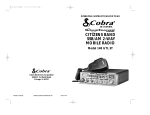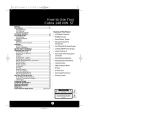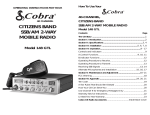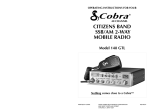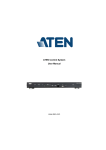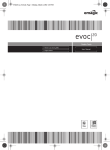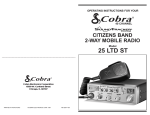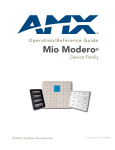Download Cobra 2010 GTL WX Operating instructions
Transcript
OPERATING INSTRUCTIONS FOR YOUR 40 CHANNEL SOLID STATE CITIZENS BAND SSB/AM TWO-WAY RADIO BASE STATION With Seven Weather Channels and NOAA Emergency Alert Tone Model 2010 GTL WX How To Use Your Cobra ® SOLID STATE CITIZENS BAND SSB/AM 2-WAY RADIO BASE STATION Model 2010 GTL WX Contents Page The CB Story .................................................................................... 1 Section I: Introduction ..................................................................... 2 Section II: Specifications ............................................................. 3, 4 Section III: Installation .................................................................... 5 Section IV: Operation ............................................................... 6 - 17 Control Functions ................................................................. 6, 7, 8 Indicator Functions ....................................................................... 9 Operating Procedure to Receive ................................................. 10 Operating Procedure to Transmit ................................................ 10 Operating Procedure to Receive Weather Band .................... 10, 11 Frequency Counter/LCD Digital Clock ........................................ 11 Receiving SSB Signals ........................................................... 13, 13 Section V: Maintenance and Adjustment ....................................... 14 FCC Warning .............................................................................. 14 Section VI: Appendix ......................................................... 15, 16, 17 Ten Code .................................................................................... 15 A Few Rules That Should Be Obeyed ......................................... 16 How Your CB Can Serve You ..................................................... 16 Use Channel 9 for Emergency Messages Only ............................ 17 Alternate Microphones and Installation .......................... 18, 19, 20 Warranty Service Instructions ..................................................... 21 Limited One Year Warranty ........................................................ 22 Cobra CB Radio Accessories .................................. Inside Back Cover The CB Story The Citizens Band lies between the shortwave broadcast and 10-meter Amateur radio bands, and was established by law in 1949. The Class D two-way communications service was opened in 1959. (CB also includes a Class A citizens band and Class C remote control frequencies.) FCC regulations permit only “transmissions” (one party to another) rather than “broadcasts” (to a wide audience). Thus, advertising is not allowed on CB Channels because that is “broadcasting.” Replacement or substitution of transistors, regular diodes or other parts of a unique nature, with parts other than those recommended by Cobra Electronics, may cause violation of the technical regulations of Part 95 of the FCC Rules, or violation of Type Acceptance requirements of Part 2 of the Rules. Citizens Band (CB) Radio operators are no longer required to obtain an FCC license to operate their CB equipment or provide station identification. Nevertheless, an operator of a CB radio station is still required to comply with the communications act and with the rules of CB Radio Operation. What Is Weather Radio? NOAA WEATHER RADIO (NWR) is a service of the National Oceanic and Atmospheric Administration (NOAA), of the U.S. Department of Commerce. It provides continuous, around-the-clock broadcasts of the latest weather information directly from National Weather Service Offices. The broadcasts are tailored to the weatherinformation needs of people within the receiving area. For example, coastal and Great Lakes' stations provide specialized weather information for area boaters, fishermen and others engaged in marine activities, as well as general weather information for the public-at-large. Three hundred eighty (380) NWR stations are in operation by the U.S. Government in addition to several NWR stations that are maintained by private interest groups. Under a January 1975 White House policy statement, NOAA Weather Radio was designated as the sole Government operated radio system to provide direct warnings into private homes for both natural disasters and nuclear attack. The capability is to supplement warnings by sirens and by commercial radio and television. NWR Frequencies and Transmission Characteristics NWR broadcasts have been allocated seven frequencies within the VHF radio spectrum reserved for Government use. Assigned frequencies are: 162.400 MHz 162.425 MHz 162.450 MHz 162.475 MHz 162.500 MHz 1 162.525 MHz 162.550 MHz Section I Introduction FREQUENCY RANGE The COBRA 2010 GTL WX transceiver represents one of the most advanced AM base station radios used as a Class D station in the Citizens Radio Service. This unit features advanced Phase Lock Loop (PLL) circuitry providing complete coverage of all 40 channels as shown below. CB Channel Channel Freq. CB Channel Freq. in MHz Channel in MHz 1 2 3 4 5 26.965 26.975 26.985 27.005 27.015 21 22 23 24 25 27.215 27.225 27.255 27.235 27.245 6 7 8 9 10 27.025 27.035 27.055 27.065 27.075 26 27 28 29 30 27.265 27.275 27.285 27.295 27.305 11 12 13 14 15 27.085 27.105 27.115 27.125 27.135 31 32 33 34 35 27.315 27.325 27.335 27.345 27.355 16 17 18 19 20 27.155 27.165 27.175 27.185 27.205 36 37 38 39 40 27.365 27.375 27.385 27.395 27.405 Weather Channel Weather Freq. in MHz 1 2 3 4 5 6 7 162.550 162.400 162.475 162.425 162.450 162.500 162.525 The COBRA 2010 GTL WX has a vastly superior receiver which includes noise blanker circuitry and a switchable automatic noise limiter. The receiver also features increased protection against cross modulation and strong adjacent channel signals. To obtain maximum performance please read carefully the descriptions and operating instructions in this manual. Fill out below;keep for your records. Serial No. Date of Purchase Dealer Name Keep this manual for detailed information about your Cobra CB radio. SAVE YOUR SALES RECEIPT, CARTON AND PACKING FOR POSSIBLE FUTURE USE. 2 Section II Specifications GENERAL Channels Frequency Range Frequency Control Frequency Tolerance Operating Temperature Range Microphone Power Source Power Consumption Current Drain (13.8V DC) Size Weight Antenna Conductor Semiconductors Meter 1 Meter 2 40. 26.965 to 27.405 MHz. Phase Lock Loop (PLL) synthesizer. ±130 Hz Typical. -30° C to + 50° C. Plug-in type; 600Ω dynamic. 120V AC nominal. 13.8V DC nominal. (Positive or negative ground). Transmit: AM full mod., 65 watts. SSB 70 watts. Receive: Squelched, 30 watts. Full audio, 40 watts. Transmit: AM and SSB, 2.2A DC (nominal). Receive: Full audio output, 1.1A DC 5”(H) x 15”(W) x 4 7/16”(D). 19 1/2 lbs. (Including speaker). UHF, S0239. 12 integrated circuits, 3 FETs, 58 transistors, 79 diodes, 1 LCD. Illuminated; indicates relative power output, received signal strength. Illuminated; indicates standing wave ratio and level of modulation. TRANSMITTER Power Output Modulation Intermodulation Distortion SSB Carrier Suppression Unwanted Sideband Frequency Response Output Impedance Output Indicators AM, 4 watts. SSB, 12 watts, PEP. High-and low-level Class B, Amplitude Modulation. SSB: 3rd order, more than -25 dB. 5th order, more than -35 dB. 55 dB. 50 dB. AM and SSB; 300 to 2500 Hz. 50 ohms, unbalanced Meter shows relative RF output power and SWR. RX/TX USB/LSB AM ANT. icons on LCD, channel frequency and clock. 3 Section II Specifications (Cont.) RECEIVER Sensitivity Selectivity Image Rejection IF Frequency Adjacent-Channel Rejection AM and SSB RF Gain Control Automatic Gain Control (AGC) Squelch ANL Noise Blanker Voice Lock Range Audio Output Power Frequency Response Built-in Speaker External Speaker (Not Supplied) SSB: 0.25 µV for 10dB (S+N)/N at greater than 1/2-watt of audio output. AM: 0.5 µV for 10 dB (S+N)/ at greater than 1/2-watt of audio output. AM: 6dB @ 3 KHz, 50 dB @ 9 KHz. SSB: 6 dB @ 1.1 KHz, 60 dB @ 2.3 KHz. More than 65 dB. AM: 7.8 MHz 1st IF, 455 KHz 2nd IF. SSB: 7.8 MHz. 60 dB AM & 70 dB SSB. 40 dB adjustable for optimum signal reception. Less than 10 dB change in audio output for inputs from 10 to 100,000 microvolts. Adjustable; threshold less than 0.25 µV. Switchable. RF type, effective on AM and SSB. ±1.5 KHz. 4 watts into 8 ohms. 300 to 2500 Hz. 8 ohms, round. 8 ohms; disables internal speaker when connected. CLOCK/COUNTER Clock Counter 24 hr. time. Displays transmit and receive frequency. WEATHER (WX) RECEIVER Type Modulation Sensitivity Frequency Range Channels Frequency Control WX Emergency Warning Audio Output Power Single Conversion, Superhet 455Hz IF. FM; ± 5 KHz Deviation. Less than 1µV for 12dB Sinad. 162.400 to 162.550 MHz. 7; 25KHz Spacing. Crystal. Phase Lock Loop; 1050Hz. 4 watts. (SPECIFICATIONS SUBJECT TO CHANGE WITHOUT NOTICE) 4 Section III Installation LOCATION Prior to beginning operation of the transceiver, a basic installation must be prepared. Installation of the transceiver itself is a rather simple procedure. In selecting the location for the unit, two basic factors must be considered: 1. Access to a 120V, 60 Hz power source. 2. The location must be convenient for running the antenna lead-in cable if outside antenna installation is proposed. BASE STATION ANTENNA Since the maximum allowable power output of the transmitter is limited by the FCC, the antenna is the most important factor affecting transmission distance. Only a properly matched antenna system will allow maximum power transfer from the 50ohm transmission line to the radiating element. The recommended method of antenna tuning is to use the built-in SWR meter to adjust the antenna tuning for minimum reflected power on channel 21. The radio may be used with any type of 50-ohm base station antenna. A ground plane vertical antenna will provide the most uniform horizontal coverage. This type of antenna is best suited for communication with a mobile unit. For point-to-point operation where both stations are fixed, a directional beam will usually increase communicating range since this type of antenna concentrates transmitted energy in one direction. The beam antenna also allows the receiver to "listen" in only one direction thus reducing interfering signals. Antenna height is an important factor when maximum range is desired. Keep the antenna clear of surrounding structures or foliage. FCC regulations for base station antenna height are: 1. Omnidirectional antennas may not be higher than 60 feet above the ground when using a tower, mast or pole, and no higher than 20 feet above an existing structure. These are only general regulations applicable to most but not all parts of the nation. Locations near airports and some military installations are subject to different rules; therfore, it is best to contact your nearest Federal Communications Commission office for information regarding your specific area. MOBILE OPERATION/EMERGENCY POWER OPERATION It is possible to operate the Cobra 2010 GTL WX from an external 13.8V DC power supply for emergency conditions or from an automobile battery for mobile operation. We recommend using a genuine Cobra DC power cord (not supplied). The DC power cord can be purchased through your local dealer, or direct from Cobra. See CB radio Accessories on the back page of this manual. 5 Section IV Operation CONTROLS AND INDICATORS There are eighteen controls, 2 meters, 1 LCD and 1 jack on the front panel of your 2010 GTL WX. 3 12 11 17 POWER 1 VOLUME 5 6 9 10 11 7 8 12 13 14 15 4 3 RF PWR 2 3 16 17 18 19 PHONE 0 20 16 1 3 SIGNAL 9 RX TX ANT +30 AM / SSB MIC DYNAMIKE 2010 GTL WX 4 5 SQUELCH RF GAIN USB LSB AM HOUR MOD MIN 1.5 FREQ. CTR BASE STA TION WITH WEATHER VOICELOCK 15 100% ANL 3 AM CH 9 10 WX 13 CAL SWR NB ALERT CLOCK LSB USB 2 0 TUNING SWR CAL SWR CAL MOD MIN MAX COARSE 2 4 5 7 8 6 14 9 A. CONTROL FUNCTIONS 1. POWER SWITCH. Press in to turn on radio. Press in, again, and release to turn off radio. 2. DYNAMIKE. Adjusts the microphone gain in the transmit mode. This controls the gain to the extent that full talk power is available several inches away from the microphone. 3. VOLUME. Turn clockwise to set the desired listening level. 4. SQUELCH . This control is used to cut off or eliminate receiver background noise in the absence of an incoming signal. For maximum receiver sensitivity the control should be adjusted only to the point where the receiver background noise or ambient background noise is eliminated. Turn fully counterclockwise then slowly clockwise until the receiver noise disappears. Any signal to be received must now be slightly stronger than the average received noise. Further clockwise rotation will increase the threshold level which a signal must overcome in order to be heard. Only strong signals will be heard at a maximum clockwise setting. 5. RF GAIN CONTROL. Adjust as required to optimize the signal. This control is used primarily to optimize reception in strong signal areas. Gain is reduced by counterclockwise rotation of the control. 6 Section IV Operation (Continued) 6. SWR CAL CONTROL . In order for you to achieve maximum radiated power and the longest range, it is important that your antenna be in good condition, properly adjusted and matched to your transceiver. The Built-in SWR (standing wave ratio) meter lets you easily measure your antenna condition. To operate this function, connect your antenna to the transceiver antenna output connector. Select a channel near the middle of the band such as 21 or the channel you plan to use most frequently. Turn the power on, set mode switch to AM, and set the meter function switch to the CAL position. Press and hold the microphone pushto-talk button and using the SWR CAL control, adjust the meter to read the CAL position indicated on the meter face. Then, without releasing the microphone button, switch the meter function switch to the SWR position and read the SWR indicated. The lower the figure, the better, with 1 being ideal. Generally speaking, readings up to 3 are acceptable, but over 3 indicates that you are losing radiated power and antenna adjustment may be advisable. This feature cannot be used in Weather Mode. 7. VOICE LOCK FINE/COURSE. Allows variation of the receiver operating frequencies above and below the assigned frequency. Although this control is intended primarily to tune in SSB signals, it may also be used to optimize AM signals. This feature cannot be used in the Weather Mode. 8. MODE SWITCH (USB/LSB/AM). This switch selects AM (Amplitutde Modulation), USB (Upper Side Band) or LSB ( Lower Side Band) mode of operation. The Mode selector switch changes the mode of operation of both the transmitter and receiver simultaneously. This feature cannot be used in the Weather Mode. 9. CHANNEL SELECTOR. In the CB Mode, this electronic selector selects any one of the forty Citizens Band channels desired. The selected channel appears on the LCD readout directly above the Channel Selector knob. In WX Mode, any one of the 7 Weather Channels will be selected. 10. INSTANT CHANNEL 9 BUTTON. Use to activate Emergency Channel 9 instantly. 11. ANL SWITCH. In the ANL position, the noise reduction circuits of the Automatic Noise Limiter are activated. This feature cannot be used in the Weather Mode. 12. NB SWITCH. When this switch is placed in the NB position the RF noise blanker is activated. The RF noise blanker is very effective for repetitive impulse noise such as ignition interference. This feature cannot be used in the Weather Mode. 13. WX/CB SWITCH. Selects the mode of operation. In the CB position, the WX function is placed in Alert mode and the unit will transmit and receive on the selected CB frequency. In the WX position, select one of 7 Weather Channels for continous WX monitoring. Note: Clock is displayed when in Weather Mode. 14. SWR/SWR CAL/MOD SELECTOR. In the MOD position, the MOD meter is activated. When in the SWR or SWR CAL positions the SWR meter is activated. This feature cannot be used in Weather Mode. In USB or LSB mode, the MOD meter does not operate. 7 Section IV Operation (Continued) 15. PRESS-TO-TALK MICROPHONE. The receiver and transmitter are controlled by the press-to-talk switch on the microphone. Press the switch and the transmitter is activated; release switch to receive. When transmitting, hold the microphone two inches from the mouth and speak clearly in a normal "voice." The radio is supplied with a low-impedance 500-ohm dynamic desktop microphone. For installation instructions on other microphones, see "ALTERNATE MICROPHONES AND INSTALLATION. 16. HEAD PHONE JACK. For your individual listening with head phones. 17. EXTERNAL SPEAKER (Optional). The External Speaker Jack is used for remote receiver monitoring. The external speaker should have 8-ohm impedance and be rated to handle at least 4.0 watts. When the external speaker is plugged in, the internal speaker is automatically disconnected. • WX ALERT TONE. If threatening weather is nearby, the National Weather Service may broadcast a 10 second alert tone. This tone will be heard through the CB, even if the CB/WX Switch is in the CB mode or the unit is turned off (see NOTE below). This enables you to monitor CB frequencies and still be warned by the National Weather Service Emergency Alert. When you hear the Alert, place the CB/WX switch in the WX position. You will then be able to hear the Weather Warning Broadcast. NOTE: If you are using the CB mode, remember to change the CB/WX Switch from CB to WX every so often to make sure you are continually tuned to the clearest weather band channel in case an alert is broadcast. 8 Section IV Operation (Continued) POWER 6 5 3 7 1 2 100% ANL VOLUME 5 6 9 10 11 7 8 12 13 14 15 4 3 RF PWR 2 3 16 17 18 19 PHONE 0 20 1 3 SIGNAL DYNAMIKE 2010 GTL WX 4 5 9 +30 RX TX ANT AM / SSB MIC 4 SQUELCH RF GAIN USB LSB AM HOUR MOD MIN 2 1.5 FREQ. CTR BASE STA TION WITH WEATHER ALERT CLOCK VOICELOCK LSB USB AM 3 0 CH 9 CAL SWR NB WX TUNING SWR CAL SWR CAL MOD MIN MAX COARSE 8 INDICATOR FUNCTIONS 1. MODULATION METER. Indicates the percent modulation (AM only). NOTE The SWR/SWR CAL/MOD switch must be in the MOD position to read modulation. 2. SWR METER. Measures the ratio of standing wave voltage of the antenna system. Used to properly adjust the length of the antenna, and to monitor the quality of the coaxial cable and all RF electrical connections. If there is any degradation whatsoever in any of the above, due to humdidity, salt spray, vibration or corrosion, the SWR meter reading will rise, therby indicating that a problem exists. To calibrate, switch to the CAL position. Transmit by pressing the mic switch (AM mode), and adjust the SWR/CAL control to the CAL mark on the meter. Then switch to SWR position for the SWR measurement. 3. S/RF METER. Indicates relative output power and incoming signal strength. 4. CHANNEL INDICATOR. The selected channel appears on the LCD left of the channel selector knob. 5. RECEIVE INDICATOR (RX). Appears in LCD. 6. TRANSMIT INDICATOR (TX). Appears in LCD. 7. MODE INDICATOR (USB/LSB/AM). Mode appears in LCD when set by mode selector. 8. ANTENNA WARNING INDICATOR. Appears on the lower left corner of the LCD if there is a serious degradation of the antenna system SWR due to humidity, salt spray, vibration or corrosion. 9 Section IV Operation (Continued) OPERATING PROCEDURE TO RECEIVE 1. Place the WX/CB Switch in the CB position. 2. Turn the set ON by pressing the POWER Switch. 3. Adjust the VOLUME for a comfortable listening level. 4. Set the Channel selector switch to the desired channel. 5. Set RF GAIN fully clockwise. 6. Set the Mode Selector to desired mode for LSB, AM or USB. 7. Adjust the VOICE LOCK control to clarify the SSB signals or to optimize AM signals. 8. Listen to the background noise from the speaker. Turn the SQUELCH control slowly clockwise, until the noise JUST disappears. (No signal should now be present.) Leave the control at this setting. The SQUELCH is now properly adjusted. The receiver will remain quiet until a signal is actually received. Do not advance the control too far, or some of the weaker signals will not be heard. OPERATING PROCEDURE TO TRANSMIT 1. Select the desired channel of transmission. 2. Set the DYNAMIKE control fully clockwise. 3. If the channel is clear, press the push-to-talk switch on the microphone and speak in a normal voice. The S-RF meter will indicate relative power output and the modulation meter will indicate percentage of modulation as you speak into the microphone. CAUTION Be sure the antenna is properly connected to the radio before transmitting. Prolonged transmitting without an antenna or a poorly matched antenna could cause damage to the transmitter. OPERATING PROCEDURE TO RECEIVE WEATHER BAND 1. Place WX/CB Switch in the WX position. 2. Turn the Weather Channel Selector (1-7) until you find the Weather Channel with the clearest reception. Sometimes more than one channel can be received depending on your location in the broadcast area; however, the closest broadcast to you will be the one with the clearest signal (the least static or background noise). 10 Section IV Operation (Continued) OPERATING PROCEDURE TO RECEIVE WEATHER BAND continued 3. If threatening weather is nearby, the National Weather Service may broadcast a 10 second alert tone. This tone will be heard through the CB, even if the WX/CB Switch is in the CB mode or the unit is turned off (see NOTE below). This enables you to monitor CB frequencies and still be warned by the National Weather Service Emergency Alert. When you hear the alert, place the WX/CB Switch in the WX position. You will then be able to hear the Weather Warning Broadcast. NOTE: If you are using the CB Mode, remember to change the WX/CB Switch from CB to WX every so often to make sure you are continually tuned to the clearest weather band channel in case an alert is broadcast. FREQUENCY COUNTER/LCD DIGITAL CLOCK 1. Located on the right side of the LCD is the Counter/Clock Indicator. 2. For proper procedure to set your LCD Clock, there are the following features: TIME SET: 2 switches (used to set time). COUNTER/CLOCK: 1 switch (used to select display). TO SET TIME 1. Press FREQ. CTR./CLOCK Switch to select the clock. 2. HOUR SWITCH: Press this switch to get correct hour setting. 3. MINUTE SWITCH: Press this switch to get correct minutes setting. NOTE: the 2010 GTL WX uses a 24-hour clock display (no a.m. or p.m. indicated). Example: Display Reads 01:00 12:00 18:00 24:00 Time Is: 1:00 a.m. 12:00 noon 6:00 p.m. 12:00 midnight FREQ. CTR./CLOCK: On power up, the display shows channel number and frequency being received. Pressing thr FREQ. CTR./ CLOCK button will select the Clock. Clock mode only is displayed in the WX (weather) mode. When switching out of WX mode, the display will continue to show the clock until the FREQ. CTR./CLOCK button is pressed again. 11 Cobra ® 2010 GTL WX HOUR RX LSB : MIN FREQ. CTR. CLOCK Display in RX mode with Clock showing. Section IV Operation (Continued) RECEIVING SSB SIGNALS There are three types of signals presently used for communications in the Citizens Band: AM, USB, and LSB. When the MODE switch on your unit is placed in the AM position, only standard double-sideband, full carrier signals will be detected. An SSB signal may be recognized while in the AM mode by its characteristic “Donald Duck” sound and the inability of the AM detector to produce an intelligible output. The USB and LSB modes will detect upper sideband and lower sideband respectively, and standard AM signals. SSB reception differs from standard AM reception in that SSB receiver does not require a carrier or opposite sideband to produce an intelligible signal. A single-sideband transmitted signal consists only of the upper or the lower sideband and no carrier is transmitted. The elimination of the carrier from the AM signal helps to eliminate the biggest cause of whistles and tones heard on channels which make even moderately strong AM signals unreadable. Also, SSB takes only half of an AM channel, therefore two SSB conversations will fit into each channel, expanding the 40 AM channels to 80 SSB channels. The reduction in channel space required also helps in the receiver because only half of the noise and interference can be received with 100% of the SSB signal. An SSB signal may be received only when the listening receiver is functioning in the same mode. In other words, an upper sideband signal (USB) may be made intelligible only if the receiver is functioning in the USB position. If a lower sideband (LSB) signal is heard when the receiver is in the USB mode, no amount of tuning will make the signal intelligible. The reason for this may be understood if you consider that when the modulation is applied to the transmitter’s microphone in the USB mode, the transmitter’s output frequency is increased whereas in the LSB mode the transmitter’s output frequency is decreased. The result in listening to the receiver is that when the MODE switch is in the proper position (either USB or LSB), a true reproduction of single tone of modulation will result, and if the tone is increased in frequency (such as a low-pitched whistle or a high-pitched whistle) you will hear the increase in the output tone of the receiver. If the incorrect mode is selected, an increase in tone of a whistle applied to the transmitter will cause a decrease in the resultant tone from the receiver. Thus when a voice is used in place of a whistle or tone, in the proper listening mode the voice will be received correctly whereas in the incorrect mode, the voice will be translated backwards and cannot be made intelligible by the voice lock control. When listening to an AM transmission, a correct sideband is heard in either mode since both upper and lower sideband are received. 12 Section IV Operation (Continued) RECEIVING SSB SIGNALS continued Once the desired SSB mode has been selected, frequency adjustment may be necessary in order to make the incoming signal intelligible, the VOICE LOCK control allows the operator to vary frequency above and below the exact-center frequency of the received signal. If the sound of the incoming signal is high or low pitched, adjust the operation of the VOICE LOCK. Consider it as performing the same function as a phonograph speed control. When the speed is set too high, voices will be high-pitched and if set too low, voices will be low-pitched. Also, there is only one correct speed that will make a particular record produce the same sound that was recorded. If the record is played on a turntable that rotates in the wrong direction (opposite sideband) no amount of speed control (VOICE LOCK) will produce an intelligible sound. An AM signal received while listening in one of the SSB modes will produce a steady tone (carrier) in addition to the intelligence, unless the SSB receiver is tuned to exactly the same frequency by the VOICE LOCK control. For simplicity it is recommended that the AM modes be used to listen to AM signals. 13 Section V Maintenance and Adjustment The COBRA 2010 GTL WX transceiver is specifically designed for the environment encountered in base station installations. The use of all solid state circuitry and its light weight result in high reliability. Should a failure occur, however, replace parts only with identical parts. Do not substitute. Refer to the schematic diagram and parts list. NOTE If the performance described in the OPERATION and MAINTENANCE AND ADJUSTMENT sections is not obtained, review the operating instructions to insure that proper procedures were followed. If a problem still exists, refer to WARRANTY SERVICE INSTRUCTIONS elsewhere in this manual. FCC WARNING All transmitter adjustments other than those provided on front panel by the manufacturer must be made by or under the supervision of the holder of an FCC-issued general radio-telephone operator’s license. 14 Section VI Appendix Citizens Band operators have largely adopted the “10-code” for standard questions and answers. Its use permits faster communications and better understanding in noisy areas. The following table lists some of the more common codes and their meanings. 10 CODE Code Meaning 10-1 Receiving poorly 10-2 Receiving well 10-3 Stop transmitting 10-4 OK, message received 10-5 Relay message 10-6 Busy, stand by 10-7 Out of service, leaving air 10-8 In service, subject to call 10-9 Repeat message 10-10 Transmission completed, standing by 10-11 Talking too rapidly 10-12 Visitors present 10-13 Advise Weather/Road conditions 10-16 Make pick up at 10-17 Urgent business 10-18 Anything for us? 10-19 Nothing for you, return to base 10-20 My location is 10-21 Call by telephone 10-22 Report in person to 10-23 Stand by 10-24 Completed last assignment 10-25 Can you contact 10-26 Disregard last information 10-27 I am moving to channel 10-28 Identify your station 10-29 Time is up for contact 10-30 Does not conform to FCC rules 10-32 I will give you a radio check 10-33 EMERGENCY TRAFFIC 10-34 Trouble at this station 10-35 Confidential information 10-36 Correct time is 15 Code Meaning 10-37 Wrecker needed at 10-38 Ambulance needed at 10-39 Your message delivered 10-41 Please turn to channel 10-42 Traffic accident at 10-43 Traffic Tie up at 10-44 I have a message for you 10-45 All units within range please report 10-50 Break channel 10-60 What is the next message number? 10-62 Unable to copy, use phone 10-63 Net directed to 10-64 Net clear 10-65 Awaiting your next message/assignment 10-67 All units comply 10-70 Fire at 10-71 Proceed with transmission in sequence 10-77 Negative contact 10-81 Reserve hotel room for 10-82 Reserve room for 10-84 My telephone number is 10-85 My address is 10-91 Talk closer to mike 10-93 Check my frequency on this channel 10-94 Please give me a long count 10-99 Mission completed, all units secure 10-200 Police needed at Section VI Appendix (Continued) A FEW RULES THAT SHOULD BE OBEYED 1. You are not allowed to carry on a conversation with another station for more than five minutes at a time without taking a one-minute break, to give others a chance to use the channel. 2. You are not allowed to blast others off the air by over-powering them with illegally amplified transmitter power, or illegally high antennas. 3. You can’t use the CB to promote illegal activities. 4. You are not allowed to use profanity. 5. You may not play music in your CB. 6. You may not use your CB to sell merchandise or professional service. HOW YOUR CB CAN SERVE YOU • • • • • • • • • Warn of traffic tie ups ahead. Provide weather and road information. Provide help fast in event of emergency or breakdown. Suggest good spots to eat and sleep. Make long trips more interesting, and help keep you awake. Provide direct contact with your office or home. Make friends for you as you travel. Provide “local information” to find you destination. Help law enforcement officers by reporting drunk and reckless drivers. Colonel Samuel S. Smith of the Missouri Highway Patrol called the number of drunken drivers, wrong-way drivers and speeders reported by CBers as “amazing.” He said, that even the “Smokey Bear” warnings don’t shake their beliefs that “the potential benefits of CB radio to law enforcement are so great that they far outweigh the disadvantages.” In regards to CB radar warnings to other CBers, Colonel Smith said cheerfully that “We’ve overheard warnings being relayed to truckers long after our operations have been discontinued...so we actually receive a residual benefit from these warnings.” 16 Section VI Appendix (Continued) USE CHANNEL 9 FOR EMERGENCY MESSAGES ONLY FCC gives the following examples of permitted and prohibited types of communications for use on Channel 9. These are guidelines and are not intended to be allinclusive. Permitted Example Message Yes ”A tornado sighted six miles north of town.” No ”This is observation post number 10. No tornado sighted.” Yes ”I am out of gas on Interstate 95.” No ”I am out of gas in my driveway.” Yes There is a four-car collision at Exit 10 on the Beltway, send police and ambulance.” No ”Traffic is moving smoothly on the Beltway.” Yes ”Base to Unit 1, the Weather Bureau has just issued a thunder storm warning. Bring the sailboat into port.” No ”Attention all motorists. The Weather Bureau advises that the snow tomorrow will accumulate 4 to 6 inches.” Yes “There is a fire in the building on the corner of 6th and Main Streets.” No “This is Halloween patrol unit number 3. Everything is quiet here.“ 17 Section VI IV Appendix Operation(Continued) (Continued) ALTERNATE MICROPHONES AND INSTALLATION For best results, the user should select a low-impedance dynamic type microphone or a transistorized microphone. Transistorized type microphones have a low output impedance characteristic. The microphones must be provided with a five-lead cable. The audio conductor and its shielded lead comprise two of the leads. The third lead is for receive control, the forth is for grounding and fifth is for transmit control. The microphone should provide the functions shown in schematic below. 5 WIRE MIC CABLE Pin Number Mic Cable Lead 1 2 3 4 5 Audio Lead Audio Shield Receive Control Grounding Transmit Control Fig. 1. Cobra 2010 GTL WX microphone schematic. If the microphone to be used is provided with pre-cut leads, they must be revised as follows. 1. Cut leads so that they extend 7/16” beyond the plastic insulating jacket of the microphone cable (see Fig. 2.) 2. All leads should be cut to the same length. Strip the ends of each wire 1/8” and tin the exposed wire. Before beginning the actual wiring, read carefully, the circuit and wiring information provided with the microphone you select. Use the minimum lead required in soldering the connections. Keep the exposed wire lengths to a minimum to avoid shorting when the microphone plug is reassembled. 18 Section VI Appendix (Continued) Fig. 4. Microphone plug pin numbers viewed from rear of pin receptacle. Be sure that the housing and the knurled ring of Fig. 3 are pushed back onto the microphone cable before starting to solder. If the washer is not captive to the pin receptacle body, make sure that it is placed on the threaded portion of the pin receptacle body before soldering. If the microphone jack is used to hold the pin receptacle during soldering operation, best results are obtained when the connections to pins 1 and 3 are made first and then the connections to pins 2, 4 and 5. Use a minimum amount of solder and be careful to prevent excessive solder accumulation on pins, which could cause a short between the pin and the microphone plug housing. 6. When all soldering connections to the pins of the microphone are complete, push the knurled ring and the housing forward and screw the housing onto the threaded portion of the pin receptacle body. Note the location of the screw clearance hole in the plug housing with respect to the threaded hole in the pin receptacle body. When the housing is completely threaded into the pin receptacle body, a final fraction of a turn either clockwise or counterclockwise may be required to align the screw hole with the threaded hole in the pin receptacle body. When these are aligned, the retaining screw is then screwed into place to secure the housing to the pin receptacle body. 7. The two cable clamp retainer screws should now be tightened to secure the housing to the microphone cord. If the cutting directions have been carefully followed, the cable clamp should secure to the insulation jacket of the microphone cable. 8. Upon completion of the microphone plug wiring, connect and secure the microphone plug in the transceiver. 19 Section VI Appendix (Continued) Fig. 2. Microphone Cable Preparation To wire the microphone cable to the plug provided, proceed as follows. Fig. 3. Microphone plug wiring. 1. Remove the retaining screw. 2. Unscrew the housing from the pin receptacle body. 3. Loosen the two cable clamp retainer screws. 4. Feed the microphone cable through the housing, knurled ring and washer as shown Fig. 3B. 5. The wires must now be soldered to the pins as indicated in the above wiring tables. If a vise or clamping tool is available it should be used to hold the pin receptacle body during the soldering operation, so that both hands are free to perform the soldering. If a vise or clamping tool is not available, the pin receptacle body can be held in a stationary position by inserting it into the microphone jack on the front panel. The numbers of the pins of the microphone plug are shown in Fig 4, as viewed from the back of the plug. Before soldering the wire to the pins, pre-tin the wire receptacle of each pin of the plug. 20 If You Need Service If You Think You Need Service, Call 773-889-3087 You may be asked to send your unit to the Cobra factory. It will be necessary to furnish the following, in order to have the product serviced and returned. 1. For Warranty Repair, include some form of proof-of-purchase, such as a mechanical reproduction or carbon or a sales receipt. If you send the original receipt it cannot be returned. 2. Send the entire product. Must include CB unit and microphone. 3. Enclose a description of what is happening with the unit. Include a typed or clearly printed name and address of where the unit is to be returned. 4. Pack unit securely to prevent damage in transit. If possible, use the original packing material. 5. Ship prepaid and insured by way of a traceable carrier ( to avoid loss in transit) such as United Parcel Service (UPS), Roadway Parcel Service (RPS) or First Class Insured Mail to Cobra Factory Service, Cobra Electronics Corporation, 6500 W. Cortland St., Chicago, IL 60707. Cobra is not responsible for units not received if package has not been properly insured. 6. If the unit is in warranty, upon receipt of your unit it will either be repaired or exchanged depending on the model. Please allow approximately 3 to 4 weeks before contacting us for status. If the unit is out of warranty a letter will automatically be sent informing you of the repair charge or replacement charge. If you have any questions, please call 773-889-3087 for assistance. For technical assistance, please call our Automated Help Desk which can assist you by answering the most frequently asked questions about Cobra products. (773) 889-3087 24 hours a day, 7 days a week. A Consumer Service Representative can be reached through this same number 8:00 am - 8:00 pm, Monday through Friday, CST. Technical assistance is also available on-line in the Frequently Asked Question (FAQ) section at www.cobraelec.com or by e-mail to [email protected] 21 WARRANTY Limited Two Year Warranty COBRA ELECTRONICS CORPORATION warrants that its COBRA citizens band (CB) radio, and the component parts thereof, will be free of defects in workmanship and materials for period of two (2) year from the date of first consumer purchase. This warranty may be enforced by the first consumer purchaser, provided that the product is utilized within the U.S.A. COBRA will, without charge, repair or replace, at its option, defective citizens band (CB) products or component parts upon delivery to the COBRA factory Service Department, accompanied by proof of the date of first consumer purchase, such as a duplicated copy of a sales receipt. You must pay any initial shipping charges required to ship the product for warranty service. The return charges will be at Cobra’s expense, if the product is repaired or replaced under warranty. For further details concerning procedures for obtaining service, see the “If You Need Service” section of the Owner’s Manual. Exclusions: This limited warranty does not apply; 1) to any product damaged by accident; 2) in the event of misuse or abuse of the product or as a result of unauthorized alterations or repairs; 3) if the serial number has been altered, defaced or removed; 4) if the owner of the product resides outside the U.S.A. All implied warranties, including warranties of merchantability and fitness for a particular purpose are limited in duration to the length of this warranty. COBRA shall not be liable for any incidental, consequential or other damages; including, without limitation, damages resulting from loss of use or cost of installation. Some states do not allow limitations on how long an implied warranty lasts and/or do not allow the exclusion or limitation of incidental or consequential damages, so the above limitations may not apply to you. This limited warranty gives you specific legal rights, and you may also have other rights which vary from state to state. Cobra Electronics Corporation, 6500 W. Cortland Street, Chicago, IL 60707 22 FOLD THIS FLAP OVER BOTTOM AND TAPE IT DOWN AND SIDES TO CLOSE COBRA CB RADIO ACCESSORIES Cost Ea. X Qty. = Amount AT-55 Cellular-Style Glass-Mount Antenna for 2010 GTL WX AT-55 $24.95 CA-72 BASE STATION MICROPHONE with 5-pin connector for 2010 GTL WX CA-72 $53.95 CA-78, MOBILE POWER MICROPHONE Amplified Power Microphone with 5-pin connector for 2010 GTL WX CA-78 $39.95 ATW-400 DUAL BAND ANTENNA, Magnetic mount with 15' RG58U Cable and PL-259 connector ATW-400 $39.95 ATW-480 DUAL BAND ANTENNA Truck mirror mount with 1.2 meter 3/8" fiberglass whip, weather tunable ATW-480 $29.95 ATW-500 DUAL BAND ANTENNA 48" whip, magnet mount with 16’ 8240 cable & PL-259 connector ATW-500 $49.95 ATW-1000 DUAL BAND ANTENNA Magnet mount with16' 8240 cable and PL-259 connector ATW-1000 $89.95 ATW-2000 DUAL BAND ANTENNA Truck mirror mount, 48" stainless steel whip, weather tunable ATW-2000 $69.95 DC POWER CORD for 2010 GTL WX PC-2010 $5.00 93 ATW INDOOR DUAL BAND (CB/WEATHER) BASE STATION ANTENNA with 15 ft. coaxial cable ATW-93 ★★ Illinois residents add 7% Cook County, IL residents additional .75% (7.75% total) ★★ Chicago, IL residents additional 1% (8.75% total) ★★ Indiana residents add 5% ★★ Michigan residents add 6 % ★★ Ohio residents add 6% ★★ Wisconsin residents add appropriate % ★★ $44.95 Amount (Tax if applicable ★★) Shipping / handling Total★★ Make check or money order (no stamps) payable to : Cobra Accessories Dept. 6500 W. Cortland St., Chicago, IL 60707 or call 773-889-3087 for credit card orders. Please print clearly—this is shipping label. Name Address (Not P.O. Box) City State THIS LINE SECOND Part No. FOLD ALONG CUT ALONG FOLD ALONG DOTTED LINE THIS LINE FIRST Description Zip Allow 4 to 6 weeks delivery. Offer valid in Continental U.S. only. $3.50 FOLD HERE TO MAKE SELF MAILER PLACE STAMP HERE Cobra ® Cobra Electronics Corporation 6500 W. Cortland Street Chicago, IL 60707 PRINTED IN MALAYSIA ©COBRA ELECTRONICS CORP. 1996 480-114-P-001



























